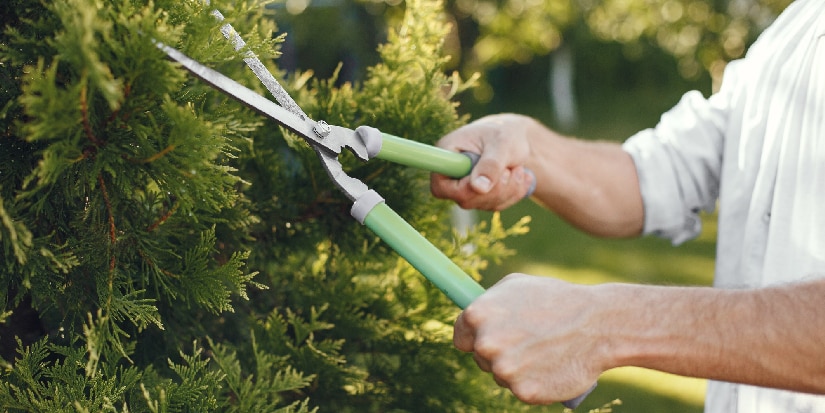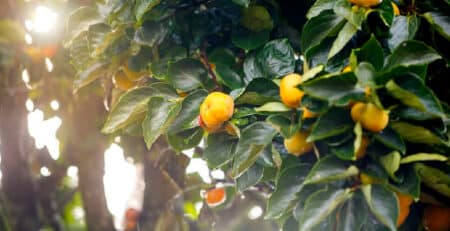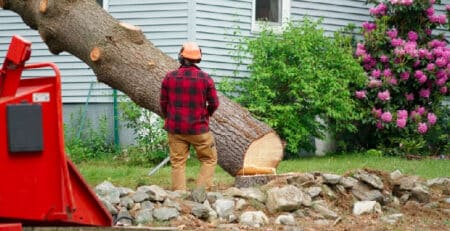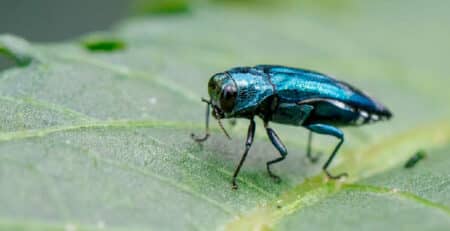What is Pruning? (Benefits, Methods, and FAQ)
When a gardener selectively chooses which branches to trim off a plant or bush, it is called pruning. By doing this, the gardener can control the plant’s development and growth into certain patterns. The branch (or shoot) on woody plants has a terminal bud at the end; this determines the specific pattern or position of buds and future branch growth. The plant species has an impact on the pattern too.
Pruning is a process of removing overgrown or dead stems and branches, promoting new growth. However, the best method of pruning is different between garden plants, shrubs, and trees, such as rose bushes.
 Pruning Trees or Shrubs
Pruning Trees or Shrubs
When pruning, gardeners use a rule of thumb “If you do not have a good reason for pruning, don’t do it.” Most types of shrubs and trees naturally grow better when not touched. The characteristics of growth and shape vary between species; when pruning is required, keep the species natural habits in mind. Additionally, when pruning is required, always follow proper methods.
What is Pruning: Purpose of Pruning
There are several reasons gardeners prune plants and bushes. It increases airflow to the rest of the plant to encourage increased branch distribution, and it will develop healthier and fuller. Being healthier, it will be less susceptible to disease. Meanwhile, pruning after blooming maximizes the next season’s bloom. The rule of thumb here is, “cut clean, leave no stub behind.”
Pruning top of plants when planting will help balance the root lost during transplant. Pruning should be no more than one-third of top growth, helping to start training the tree.
 Training The Plant
Training The Plant
For the tree to develop a strong root system to withstand winds, they need to be pruned to allow a few strong branches to be spaced around, up, and down the trunk. This will help train a shade tree to grow with limbs branching out at a greater height ranging 1.6 to 2.4 meters, while low-hanging branches should be removed.
However, when pruned all at once time, it can cause the tree to become weak and will need staking. When pruning all at once, lower branches need to be cut to stubs, which will be removed later but act as sap drawers to create leafy shoots to draw water and food to provide the tree with needed nutrients. The stubbed branches will need to be maintained back, pruning fully after the crown (permanent scaffold branches) are established.
Tree Health
To ensure your tree trunk grows strong, prune weaker limbs, including those that cross others, limbs with weak crotches, and limbs that compete for space within the crown. Prune dead branches to increase the overall appearance and reduce insects and disease from spreading.
Pruning the crown can revitalize an old tree, lowering the amount of work the root system must do to supply nutrients to the leaf areas. Pruning also increases airflow into the tree and surrounding landscape, and sunlight can reach more areas too. Finally, pruning will aid in the better growth of remaining branches.
Safety Tip: You should always remove branches that could be a hazard to people, buildings, or vehicles. Broken, dead, split, weak, or low hanging branches.
 Pruning Benefits
Pruning Benefits
Promotes Plant HealthWhen dead or decaying branches are pruned, it provides room for additional growth. The trunk can provide nutrients to the remaining branches to develop stronger and protects the surrounding area from falling branches. Additionally, it deters animal and pest infestations that can result in disease.
1. Protects Property and Family
Pruning regularly will lower the risk of storm damage caused by broken or dead branches. Therefore, protecting structures around the tree(s) and your family from being hit by falling branches over driveways, walkways, or children playing in the yard.
2. Maintain Landscapes and Plants
Regular pruning will encourage plants and trees to grow healthier and produce better. Additionally, keeping hedges and branches trimmed increases the aesthetics of the landscape and maintains a proportioned growth. This helps you control the shape and size of your property’s landscape.
3. Appearance
The pruning process improves the overall appearance of your tree. Having overgrowth does not look pleasant and could reduce the image of commercial property. Having maintained trees look more professional and creates a better impression of the property.
4. Suppressor Stimulate Growth
Pruning can be used to suppress unwanted growth or promote new growth. Removing parts of overgrown areas sparsely will promote growth, while aggressive pruning will suppress growth.
 5. Sunlight
5. Sunlight
Pruning trees will allow sunlight to get to other plants around and under the tree. Full shade areas are often unfit for planting, including grass, because sunlight is required for adequate growth. By removing unnecessary branches, it gives the remaining plants and branches the means to grow.
6. Structural Pruning
A different structure works for each species, with slight differences between trees in the sunlight. Generally, a well-structured tree only has a single dominant trunk, with appropriate size branches attached with plenty of room for growth. A poorly structured tree with weak branches or trunks fighting for dominance often causes future issues and major hazards. It is best to start structural pruning on young trees, allowing for small pruning wounds.
7. Shape
By pruning young trees, it helps shape how they grow through proper branch structure and strength. Pruning compensates for the root loss during transplant. Additionally, when adding trees to a commercial property allows for training the shape as desired.
8. Remove Long, Heavy Limbs
Branches are attached to a main branch or trunk, while all the weight is placed on the opposite end. When it continues to grow with proper maintenance, it grows to withstand normal wind conditions, but extreme wind conditions can still cause it to sway much more until it reaches a breaking point. Although not all branches will be hazardous, those found to be excessively long or heavy by an arborist could use structural pruning.
9. Regular Canopy Maintenance
Even with proper growth, branches sometimes die within the canopy as they become older, creating advantages for new branches, which can get in the way. Other trees can also cause problems as branches fall into the tree or get stuck and create “hangers,” which could fall on people. Maintenance to clear out these “hangers” and “deadwood” along with other decaying or diseased branches will decrease risks in the future. It reduces both risks of pests and storm damage from loose branches.
 Different Methods of Pruning
Different Methods of Pruning
1. Heading
Removal of terminal limbs or shoots stimulates regrowth at the cut. Additionally, the heading is the most refreshing method for pruning which causes thick and compacted growth, with a loss of the natural form. The heading is sometimes used for ornamental shrubs that overgrow the planting area, cutting back to roughly 1 foot above ground level. This pruning type can be tolerated by various broadleaf shrubs, including crape myrtle, Ligustrum, Burford holly, and abelia. Other forms of heading include dehorning, topping, clipping and hedging.
2. Thinning
The thinning process removes the full limb or shoots to the lateral or main branch’s origin point. However, some shoot tips are undistributed, maintaining apical dominance. This results in the undisturbed shoot tip creating new growth, and the lateral bud regrowth and development is suppressed. This is often the least invigorating method of pruning, providing plants with more natural formation. Thinning is an important part of pruning maintenance used for shortening limbs, enhancing the amount of light penetration, and directly helping limb or shoot growth.
3. Drop-Crotching
The drop-crotching method is used to reduce larger trees’ size, a type of thinning that removes the main branch, cutting it to a large lateral branch. It is done by making a parallel cut to the remaining lateral. It is recommended that three cuts are used when removing larger tree limbs to prevent the bark from tearing down the trunk and causing a major wound. An unwanted thinning method includes bench cuts; a vigorous upright limb is thinned to create a horizontal limb.
Upright shoot growth is referred to as water sprouts and commonly creates a “bench” space due to a horizontal limb’s lack of apical dominance. This type of regrowth is weaker and commonly causes undesired umbrella-shapes. Instead, the proper method is to use thinning cuts on limbs with similar angles to the removed limb but no greater than a 45-60 degree from vertical. Meanwhile, a wider crotch is stronger than a narrow and weaker crotch, allowing the bark to become compressed tightly and prevent normal wood development. Narrow angled branches can split when winter ice gets trapped between them.
4. Crown Lifting
Crown lifting can be used when needing to provide clearance over paths or streets. This method removes lower hanging branches of the crown. Crown lifting provides additional light under the crown, with a low risk of altering the crown. The term ‘lifting’ means you do not prune the more visible, high areas o the crown. You should avoid leaving branches with no leaves, which are over one-third of the tree’s total height. Branches have a major role in controlling the amount of sway during high winds.
5. Crown Reduction
Trees that outgrow the space it is in could use the crown reduction method to shrink it. This works by reducing branch length to increase growth. Try focusing on creating a flowing branch line that matches the tree’s natural shape. Due to larger wounds, crown reduction is the last resort method and is rarely suggested for trees with a pyramid shape, like birches or conifers.
 6. Pollarding
6. Pollarding
Pollarding is a method often started on younger trees and frequently repeated during the lifespan of the tree. Traditionally the method is done on willows, where smaller branches are pruned to a secondary branch from the main stem. The regrowth formed since the previous pollarding gets removed to the “knuckles” o the tree. Sometimes incorrectly referred to as full branch removal of mature trees. This method also leaves larger wounds and no foliage for food production. Because this method will cause massive stress on the tree, it is the last resort method.
7. Thinning of Shrubs
If you have shrubs that you want to be more open, thinning is a method to consider. The thinning of branches or twigs provides additional room for growth on the side branches, but in most shrubs, it will not stimulate excessive growth. Additionally, it allows you to control the shape and height of the shrubs. It is recommended to thin out older and taller stems first with hand pruning shears.
8. Rejuvenation of Shrubs
We recommended removing around one-third of the oldest and tallest branches above ground level to rejuvenate your shrubs before new growth occurs.
9. Gradual Renewal of Shrubs
With this method, some of the oldest and tallest branches are removed overtime at ground level, usually annually. There may be some thinning required to reduce branch length and maintain asymmetrical shape as desired.
 Plant Healing From Pruning
Plant Healing From Pruning
Naturally, healing comes after wounding or pruning. It will begin within the cambium. That is a thin layer of cells that are found between the bark and the wood. There are areas of the cambium. These are found at the branch collar, where a ring of tissue is raised at the joint of the lateral branch and main limb, and the bark ridge found at the junction of two limbs which work to close off the wound between the pruning cut and plant. If you want to promote faster healing, then prune close to the main branch without causing damage to the branch collar or bark ridge. If you leave a stub, then it will slow down the healing process and allow for decay. Pruning paint or wound dressings are only cosmetic and hardly do anything to promote healing of pruned areas.
Trees will not heal wounds similar to other types of living organisms will. They simply seal them. Because trees are not able to replace the damaged tissue, they have developed a way to deal with life-threatening wounds. The process is called compartmentalization, and the tree will seal off the diseased or damaged tissue by creating a wall around it that encases it and allows the tree to continue to grow and flourish.
The Compartmentalization of Disease in Trees (CODIT) is a researched concept studied by Dr. Alex Shigo. Based on CODIT, four protection walls are created while the cells begin to modify themselves as a response to infection and wounds:
- Wall 1: This wall plugs the conductive vascular tissue below and above the wound, which stops the potential spread of diseased or infected tissue found in the cambium.
- Wall 2: This wall will be formed by the thick-walled latewood growth ring exterior and interior of the wound.
- Wall 3: This wall will be formed by ray cells, which will create a maze-type barrier to stop decay spread. Some cells will deal with chemical altering, which makes it toxic to certain micro-organisms.
- Wall 4: It is this wall that is the strongest and called the barrier zone or wall. It is made from a woody tissue found on the exterior of the tree. The wall will close the wound using new wood.
The whole process can be seen on a damaged or pruned tree as the growth encloses the area. For a tree to fully compartmentalize and then seal a severed branch’s exterior, it can take up to 20 years. Yet, for the tree, it is a fast-paced and effective process.
 When You Should Prune
When You Should Prune
The accepted theory is that the best time for you to prune your tree is during the dormant time. In most zones within the United States, this period is between the late fall and the early spring. Winter pruning will stimulate growth, while summer pruning will slow it down. Yet, for flowering shrubs, when you want to stimulate flower growth, you have to prune it after the flowers die, which will allow you to have an abundant and full flowering growth the following spring. Then some plants are best pruned in spring, summer, and early fall. Examples of these plants are maple trees, birch trees, and grapes. The main thing is to know your goal and know your plant to have a successful pruning and knowing when you should prune the plant.
If you are unsure how and when to prune your trees, plants, and shrubs, you should get advice from a professional arborist (for trees) and horticulturists. There are plenty of books that are available on pruning that will show you how you should prune and when you should prune your plants. Trees are better pruned when they are dormant. There are no rules that you should follow, which is why your plants’ growth habit is important. Certain trees will bleed too much sap if they are pruned during late winter or in spring, and others will do that during early fall or in summer. Then there is a chance that they develop a new soft growth that cannot handle winter. When it comes to flowering shrubs, you need to know if the blooms are produced on new growth or a year-old growth. Early spring will stimulate the growth for shrubs that will bloom on newer shoots, but the pruning after the flowering is the best for shrubs such as forsythia, which bloom on year-old wood. When you should prune your shrub, it will depend on a summer/fall flowering or a spring-flowering shrub. Spring flowering shrubs will create blooms on wood grown during the previous season and will need to be pruned after blooming to allow for new growth of wood for the blooms next season.
Many woody ornamental plants will be pruned based on their flowering date. For instance, flowering plants like forsythia and dogwood will be pruned once bloomed. Pruning a spring-flowering shrub during its dormant season will remove flower buds that were formed during the fall. Summer flowering plants will often be pruned during the winter season. If the plants are not grown for the flowers, then the best pruning time will be during winter before the new growth starts in the spring. You should not prune during the late summer or in fall as regrowth can happen and make the plants susceptible to getting injured by the cold. For instance, peach trees should not be pruned between October and January.
 What Tools or Equipment Do You Need For Pruning
What Tools or Equipment Do You Need For Pruning
A good quality pruning tool will make a big difference when pruning your shrubs and trees. When you are purchasing tools, you will normally get what you end up paying for. If you get cheap tools, then they are cheaply made. Pole or hand-mounted versions of pruning saws and secateurs are available. If you have large limbs, then you can use a bucksaw.
Learning about what plants you should prune and how you should prune them is vital, but using the right type of tools is also just as important. You should pick tools that will do the job, keep a sharp edge, and are easy to handle and sharpen. Home improvement stores and garden centers will often carry hand pruning shears. Many of them are made to cut stems that are a half-inch in diameter. You should not attempt to use hand pruning shears to cut any larger branches as it could damage your plant and ruin the shears.
1. Pruning Shears (Secateurs, Clippers, or Pruners)
These are going to be the most used tool when it comes to pruning plants. They are handheld and can cut twigs and branches that are up to ¾ inches thick. There are three types of pruning shears which are ratchets, bypass, and anvil. Ratchet pruners are similar to the anvil pruner, but they have a mechanism that will cut in stages. These are great for people who do not want to put a strain on their wrists. Anvil pruners have a straight blade that will use a splitting action. They are great for dry stems and branches. The most popular of the three is the bypass shears. They act like scissors and are great for stems.
2. Loppers
These are great for any branches up to 2 ½ inches thick and great for fruit trees, vines, and nut trees. They are similar to hand shears, but the blades are much thicker, and the handle is longer. Loppers also come in ratchet, bypass, and anvil styles.
3. Pruning Saws
A pruning saw can handle branches that are between 1 ½ inch to 5 inches in diameter and come in a variety of styles.
4. Hedge Shears
These are perfect if you have hedges, deadheading perennials, evergreens, or small shrubs. They are used to cut branches up to 2 ¼ inches in diameter.
5. Pole Pruner
If you want to reach deadwood in trees or just light pruning, then a tree pruner or pole runner is something that you should have. Pole runners are normally used on any tree and can cut branches up to 1 ¼ inch in diameter. The best part is that they can reach up to 8 feet away, eliminating you needing a ladder. It is also important to know that there are electric pole pruners.
Good equipment that is cared for will do a much better job and will last much longer. Ensure that you keep your tools sharp and that they are stored in a dry room. Also, ensure that you maintain a good operating condition by using it yearly. When you are pruning diseased plants, be sure to disinfect your tools after each cut to prevent spreading the disease to your healthy plants. Clean and then disinfect your equipment after each pruning using bleach or alcohol by mixing nine parts water into one part bleach. Ensure that you are oiling the pruning equipment to keep them rusting.







